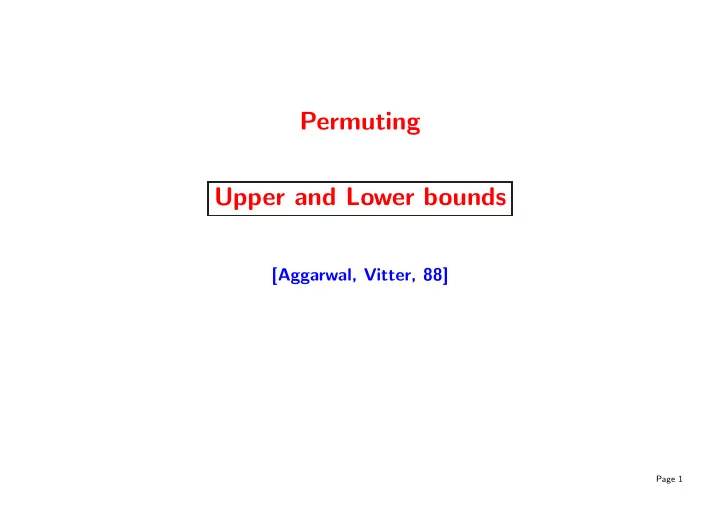

Permuting Upper and Lower bounds [Aggarwal, Vitter, 88] Page 1
Upper Bound Assume instance is specified by each element knowing its final position: 3 2 4 1 a c b d a c d b Algorithm Internal Cost I/O Cost 1) Place each element directly Θ( N ) Θ( N ) 2) Sort on final position Θ( N log N ) Θ( N/B log M/B ( N/B )) Page 2
Upper Bound Internally, 1) always best. Externally, 2) best when 1 /B log M/B ( N/B ) ≤ 1 . Note: This is almost always the case practice. Example: B = 10 3 , M = 10 6 , N = 10 30 ⇓ 1 /B log M/B ( N/B ) = 9 / 10 3 << 1 External Permuting: O (min { N/B log M/B ( N/B ) , N } ) = O (min { sort( N ) , N } ) Page 3
Lower Bound Model Model of combined memory (RAM + disk): RAM Disk · · · • Elements are indivisible: May be moved, copied, destroyed, but newer broken up in parts. • Assume M ≥ 2 B . • May assume I/Os are block-aligned, and that at start [end], input [output] is in lowest contiguous positions on disk. Page 4
Lower Bound We may assume that elements are only moved , not copied or destroyed. Reason : For any sequence of I/Os performing a permutation, exactly one copy of each element exists at end. Change all I/Os performed to only deal with these copies. Result: same number of I/Os, same permutation at end, but now I/Os only move elements. Consequence : Memory always contains a permutation of the input Recall, memory means combined memory (RAM + disk), seen as one array. Page 5
Lower Bound In analysis, keep a set S t of permutations. Maintain the following invariants: 1. S t contains all permutations of elements in memory possible to reach with t I/Os. 2. S t is closed under permutations of the elements in RAM, and under permutation of the elements inside each touched block on disk. For an I/O, let X be an upper bound on the increase of | S t | : | S t +1 | ≤ X · | S t | . Page 6
Bounds on Value of X Type of I/O Read untouched block Read touched block Write � M � M B N � � X B ! BN BN B B B For t I/Os, there are at most 3 t sequences of choices of the three types. For each sequence, there are at most N/B untouched reads. Hence, from | S 0 | = 1 and | S t +1 | ≤ X · | S t | we get � t �� M � | S t | ≤ 3 t ( B !) N/B BN B To be able to reach every possible permutation, we need N ! ≤ | S t | . Thus, � t � � M � ( B !) N/B N ! ≤ 3 BN B is necessary to reach all permutations. Page 7
Lower Bound Computation � t � � M � ( B !) N/B ≥ N ! 3 BN B � M � t (log + 3 log N ) + ( N/B ) log( B !) ≥ log( N !) B t (3 B log( M/B ) + 3 log N ) + N log B ≥ N (log N − log 2 ( e )) t ≥ N (log N − log 2 ( e ) − log B ) 3 B log( M/B ) + 3 log N N log( N/B ) t = Ω( B log( M/B ) + log N ) a) log( x !) ≥ x (log x − log 2 ( e )) b) log( x !) ≤ x log x Using Lemma: � x � c) log ≤ 3 y log( x/y ) when x ≥ 2 y y d) log(3 BN ) ≤ 3 log( N ) when 3 ≤ N , B ≤ N Page 8
Lower Bound N log( N/B ) Ω( B log( M/B ) + log N ) = Ω(min { N log( N/B ) B log( M/B ) , N log( N/B ) } ) log N = Ω(min { Z 1 , Z 2 } ) Note 1: Z 1 = sort( N ) Note 2: Z 2 < Z 1 ⇔ B log( M/B ) < log N ⇒ B < log N ⇒ Z 2 = N log( N/B ) = N (log N − log B ) = Θ( N ) log N log N Note 3: Z 2 ≤ N always By Note 2 and 3, it is OK to substitute N for Z 2 inside min . Page 9
The I/O Complexity of Permuting We have proven: Θ(min { sort( N ) , N } ) Page 10
Recommend
More recommend